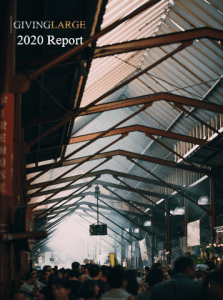According to research by Strive Philanthropy, $1.1 billion was invested by the top 50 corporate givers. This forms part of the 2020 GivingLarge Report which shines a light on Australia’s corporate contributions. B4SI supports many of those in the top 50 to measure and report their contributions using a consistent and verified approach.
Corporate Citizenship Director Simon Robinson sat down with Jarrod Miles, the founder of Strive Philanthropy to discuss the results.
 Those in the top 50 looking to better understand the impact of their contributions, please get in touch with the B4SI team.
Those in the top 50 looking to better understand the impact of their contributions, please get in touch with the B4SI team.
What were the key trends you saw from the GivingLarge data in 2020 and how did it change from 2019?
I’m pleased to report that 2020 was a record-breaking year for corporate giving amongst our largest companies. We saw a 17% increase (compared to 2019) in total contributions from our top 50 companies moving up to $1.1 billion. Unsurprisingly the increase was driven from the needs of the community in bushfires and COVID-19, with over $320 million contributed by our same top 50 to just these two causes.
Which companies made the biggest investments related to COVID-19 and what were some of the trends?
Big contributors to COVID-19 came mostly from the mining sector with BHP, Rio Tinto and Newcrest’s combined contribution adding to over $95 million. We also saw large contributions from Macquarie Group ($20M), Woodside ($10M) and South32 ($10m). These six companies contributing 77% of the total donations uncovered across more than 150 companies. Importantly while not all organisations were in a position to make large cash contributions, we noted many took the opportunity to confirm their support to existing community partners.
While the cash donations may reach the headlines, a larger amount of companies committed to community support through the provision of free product
and pro bono services. Common examples of product and service provision include supermarket food donations, contribution of real estate space and access to interest and fee free bank loans for families and businesses doing it tough. The majority of the contributions went towards areas within health, social and public welfare and education, with institutions like University of Queensland & Doherty Institute receiving donations for their COVID 19 research and non profits such as Royal Flying Doctor Service, Lifeline, Foodbank and the Smith Family all receiving donations to support their on the ground relief work.
Were there any trends that emerged within sectors?
Analysing companies by sector acts to ensure an aligned review of company contribution, eliminating cross sector variables, reporting discrepancies and allowing companies to benchmark their industry peers. Due to this our sector analysis is more meaningful. Interestingly predominately consumer facing sectors like Health Care, Consumer and Telecommunications gave larger percentages of profit to the community compared to less consumer facing sectors like Materials, Industrial and Utilities. Expectedly Real Estate community contribution was down in 2020 likely off the back of COVID-19. Materials, Finance and Consumer sectors continued to give the largest dollar amounts with companies from these sectors contributing a significant 81% of the $1.1 billion total.
What can be done to truly embed the value of corporate community investment at the board room table?
Ongoing efforts to clearly disclose corporate giving, to showcase contributions and impact and to meaningfully connect with the needs of all stakeholders will help to embed the value of community investment. Emerging evidence suggests community investment does not only support the countless charities and community organisations in need but also other important stakeholders (that help to drive the corporate agenda) like employees, customers and investors who are calling for meaningful social impact from the companies they work for or do business with.
To read more about GivingLarge click here
